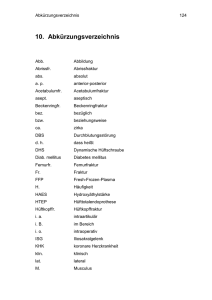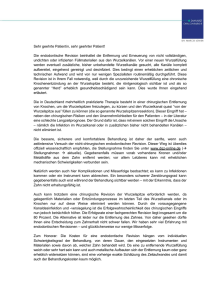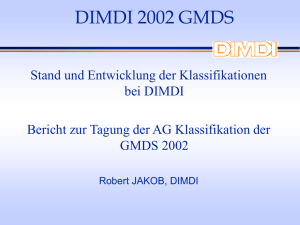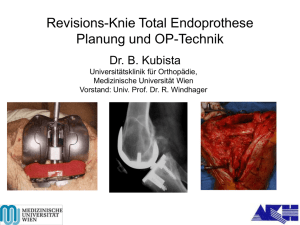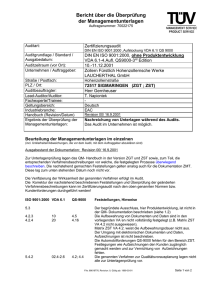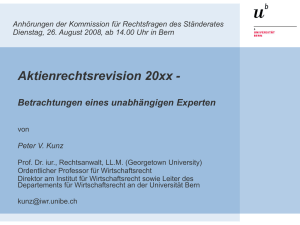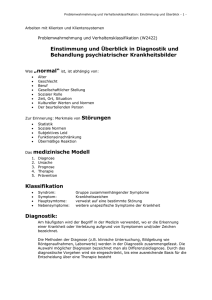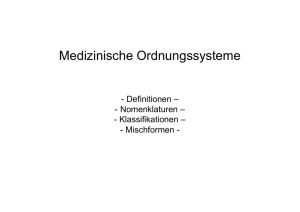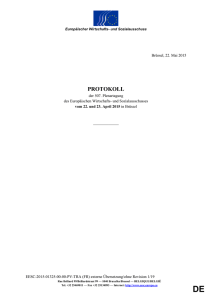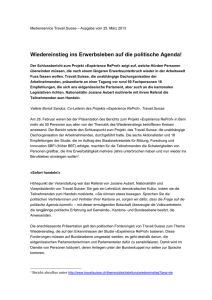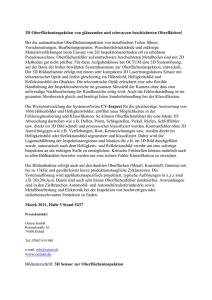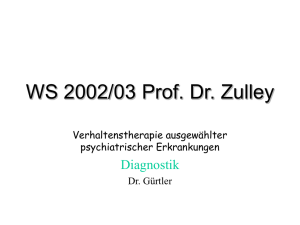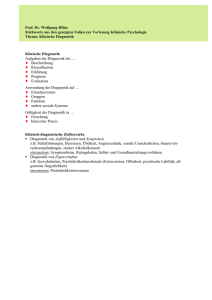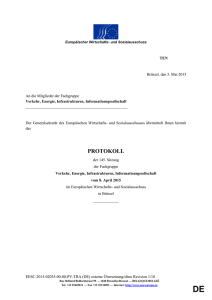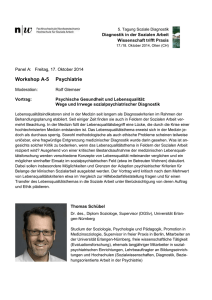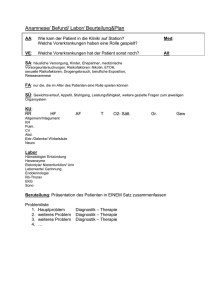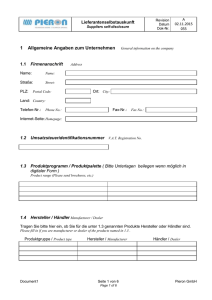Revision HTEP - Prinzipien
Werbung
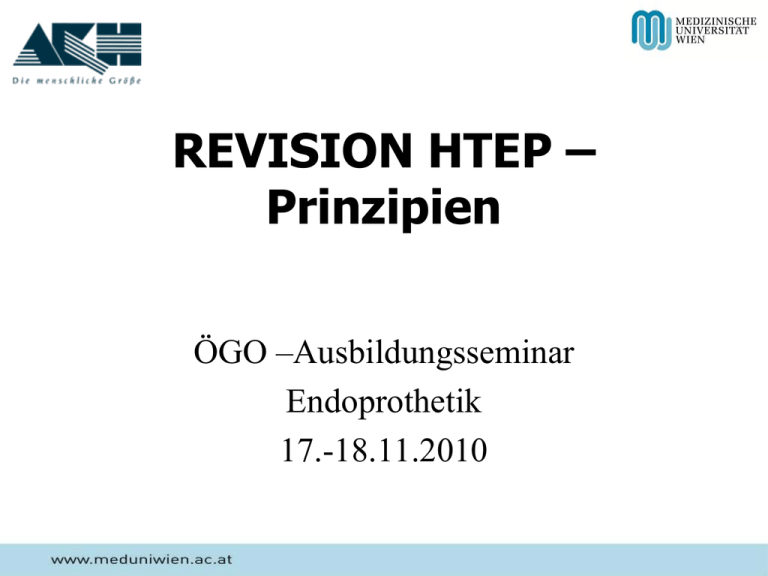
REVISION HTEP – Prinzipien ÖGO –Ausbildungsseminar Endoprothetik 17.-18.11.2010 REVISION HTEP - Allgemein • Statistik: • USA; 2005 208.600 HTEPs/Jahr 2030 572.000 HTEPs/Jahr 52% unter 65 Jahren • USA; 2005 2030 40.800 Revisionen/Jahr 96.700 Revisionen/Jahr +174% +137% Kurtz S, Ong K, Lau E, Mowat F, Halpern M, Projections of primary and revision hip and knee arthroplasty in the United States from 2005 to 2030. J Bone Joint Surg Am, 2007 REVISION HTEP - Allgemein • Daten des Nationalen Schwedischen Arthroplastik Register: 1979-2000: 178.763 primäre Hüftendoprothesen 16.577 Revisionsoperationen aseptische Lockerung - 75,3 % primäre tiefe Infektion - 7,6 % mechan.Kompl.&Luxationen - 8,8 % Malchau, H., Herberts, P., Eisler, T., Garellick, G., and Soderman, P.: The Swedish Total Hip Replacement Register. J. Bone Joint Surg. Am. 84-A Suppl 2:2-20.:2-20, 2002. Revision HTEP - Allgemein Changing Indications for Revision Total Hip Arthroplasty -- Paul F. Lachiewicz, MD; Elizabeth S. Soileau, BSN, Journal of Surgical Orthopaedic Advances, Summer 2005 Revision HTEP - Diagnostik SCHMERZ & FUNKTIONELLE BEWEGLICHKEIT AKUT-Abklärung ! Revision HTEP - Diagnostik • Indikation zur AKUT-Revision? • • • • • • • • Aseptische Lockerung (68%) Luxation (16%) Infekt (7%) Periprothetische Fraktur (3%) Nerven-,Gefässverletzungen (0.9%-,0.3%) Heterotope Ossifikationen Venöse Thromboembolie (0.5-1.3%) Beinlängendifferenz Revision HTEP - Diagnostik • Weitere Abklärung: • genaue Anamnese • klinische Untersuchung • Radiologische Untersuchung • laborchemische Analyse (BSG, CRP) • Gelenks-Punktion Cave: Ausschluss eines schleichenden Infekts! Revision HTEP - Diagnostik • Allgemeine Anamnese: • Voroperation; Zeitpunkt/Art/Anzahl - OP-Berichte • Implantat; Typ/Grösse/Gleitpaarung/Verfügbarkeit/Kompatibilit ät – Implantatausweis • Interne Vorerkrankungen; Gerinnung/DVT,PE/Neuromusk.-metabolische Störungen/Allergien? Revision HTEP - Diagnostik • Schmerzanamnese: • Seit wann? Akut, schleichend • Wie? Stechend, dumpf • Wann? nach Belastung, in Ruhe • Wo? Leiste, Oberschenkel z.B. - belastungs-/bewegungsabhängiger (beim Aufstehen) Schmerz - in der Leiste Pfannenlockerung - im Oberschenkel Schaftlockerung - Ruheschmerz Infekt Revision HTEP - Diagnostik • Klinik: • Beweglichkeit - schmerzbedingt - mechanisch bedingt (Gluteusinsuff., Beinverkürzung) Revision HTEP - Diagnostik • Radiodiagnostik: • • • • • RÖ ap/axial CT MRT EBRA (EinzelBildRöntgenAnalyse) RSA (RadioStereometrischeAnalyse) Revision HTEP - Diagnostik • Infektabklärung: • laborchemische Analyse: Serum; BSG, CRP, Leukozytenzahl, IL-6 • Gelenkspunktat (AB-Pause) • 3-Phasen-Szintigraphie (Tc-99m) • ev.Entzündungsszintigraphien (Granulozyten, Leukozyten, FDG-Pet) Revision HTEP - Diagnostik • Infektabklärung: • Intraoperativ; -- Punktate (Gramfärbung) – Abstriche – Gewebe (Biopsie, OP) – Prothesen Explantate Revision HTEP - Voraussetzung • Implantatauswahl sowie Erfahrung in der Verankerung von Revisionskomponenten. • Klassifikation Defekte nach Paprosky REVISION HTEP - Klassifikation • Klassifikation femoraler Defekte nach Paprosky: -Typ I: minimaler metaphysärer Knochendefekt -Typ II: metaphysärer Knochendefekt ....keine diaphysäre Defektbeteiligung. REVISION HTEP - Klassifikation • Klassifikation femoraler Defekte nach Paprosky Typ III A: diaphysärer Knochendefekt > 4cm unbeschädigter Knochen Typ III B: diaphysärer Knochendefekt < 4cm unbeschädigter Knochen REVISION HTEP - Klassifikation • Klassifikation femoraler Defekte nach Paprosky Typ IV: Defekt über diesen Bereich hinaus, dünne, ballonartige Kortikalis und weiter Kanal. REVISION HTEP - Therapie • Die Behandlung ist prinzipiell abhängig vom Ausmaß des verbleibenden Knochens: • Typ-I- und Typ-II-Defekte: Primärimplantate • Typ III A und III B: Implantate mit Längen von 20–35cm REVISION HTEP - Therapie • Die Behandlung ist prinzipiell abhängig vom Ausmaß des verbleibenden Knochens: • Typ-IV: modulare Revisionsimplantate & homologer Knochen bzw. Structural Allografts Megaprothesen Sporer SM, Paprosky WG: Revision total hip arthroplasty: The limits of fully coated stems. Clin Orthop Relat Res 2003; 417: 203-209 REVISION HTEP - Therapie zementfreie Revisionsimplantate haben hervorragende Ergebnisse mit einer Lockerungsrate von nur 4% nach 14 Jahren ! Weeden SH, Paprosky WG: Minimal 11-year follow-up of extensively porous-coated stems in femoral revision total hip arthroplasty. J Arthroplasty 2002; 17: 134-137 REVISION HTEP - Klassifikation • Klassifikation acetabulärer Defekte nach Paprosky: • Typ I: Pfannenrand & Pfeiler intakt Implantat >50% Kontakt mit dem Pfannenlager Paprosky, W. G., Perona, P. G., and Lawrence, J. M.: Acetabular defect classification and surgical reconstruction in revision arthroplasty. A 6-year follow-up evaluation. J. Arthroplasty. 9:1994. REVISION HTEP - Klassifikation • Klassifikation acetabulärer Defekte nach Paprosky: • Typ II: intakte vordere und hintere Pfeiler Typ II A: Defekte im superomedialen Bereich Typ II B: .....im superolateralen Bereich Typ II C: .....im Bereich des Pfannenbodens Paprosky, W. G., Perona, P. G., and Lawrence, J. M.: Acetabular defect classification and surgical reconstruction in revision arthroplasty. A 6-year follow-up evaluation. J. Arthroplasty. 9:1994. REVISION HTEP - Klassifikation • Klassifikation acetabulärer Defekte nach Paprosky: • Typ III: schwere Knochendefekte der Beckenpfeiler Typ III A; Pfannenboden & Ischium Typ III B; Diskontinuität des Beckens. Paprosky, W. G., Perona, P. G., and Lawrence, J. M.: Acetabular defect classification and surgical reconstruction in revision arthroplasty. A 6-year follow-up evaluation. J. Arthroplasty. 9:1994. REVISION HTEP - Therapie • Typ I bzw. II: Auffüllung mit homologem Knochen & Verwendung von hemisphärischen Cups (mit oder ohne Schraubenfixation) oder Schraubpfannen • Lockerungsrate 8% nach 12,5 Jahren Hallstrom BR, Golladay GJ, Vittetoe DA, Harris WH: Cementless acetabular revision with the Harris-Galante porous prosthesis: Results after a minimum of ten years of follow-up. J Bone Joint Surg Am 2004; 86-A: 1007-1011 REVISION HTEP - Therapie • Typ III: - komplexe Rekonstruktionen mit Structural Allografts und Antiprotrusionsringen. - Sockelpfannen • ....mittelfristig wechselhafte Ergebnisse Paprosky W, Sporer S, O´Rourke MR: The treatment of pelvic discontinuity with acetabular cages. Clin Ortho Relat Res 2006; 453: 183-187 REVISION HTEP - Therapie • Typ III: • alternative Ersatzmaterialien poröses Tantalum in Form von Metall-Augments Die ersten Ergebnisse dieser „trabekulären MetallAugments“ sind vielversprechend. Sporer SM, Paprosky WG: The use of a trabecular metal acetabular component and trabecular metal augment for severe acetabular defects. J Arthroplasty 2006; 21: 83-86 Sporer SM, Paprosky WG: Acetabular Revision using a trabecular metal acetabular component for severe acetabular bone loss associated with a pelvic discontinuity. J Arthroplasty 2006; 21 DANKE ! R.Lass
